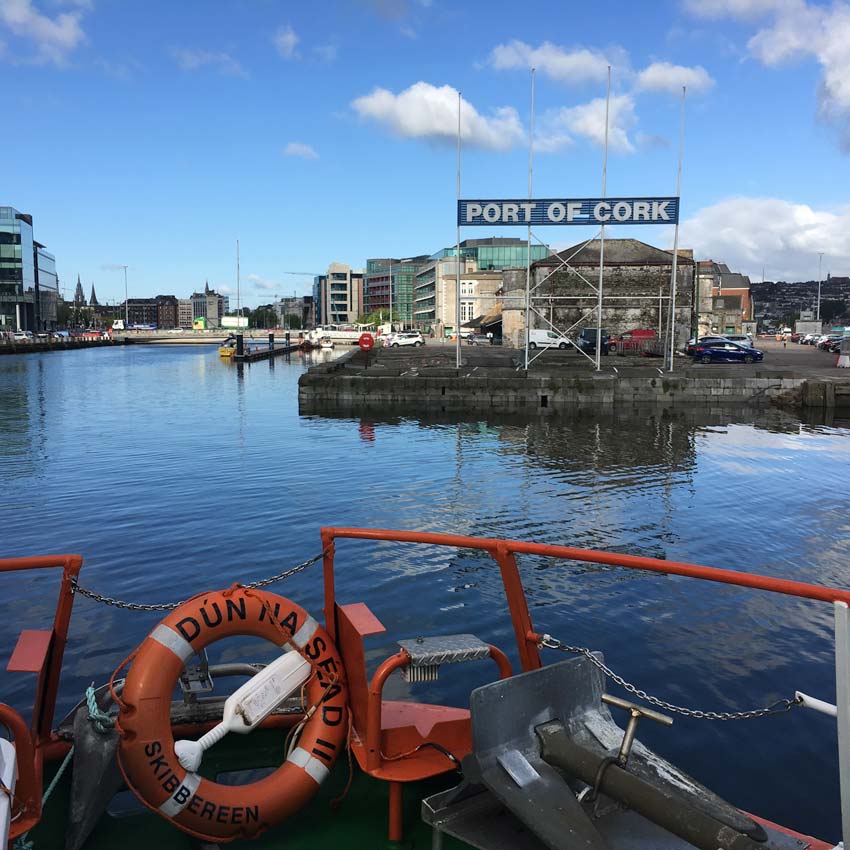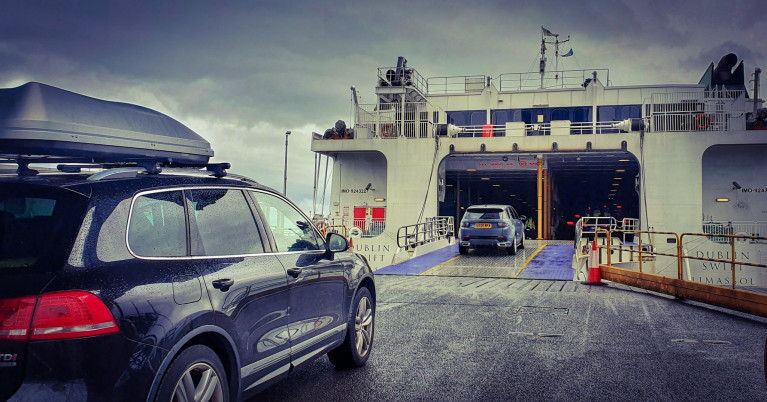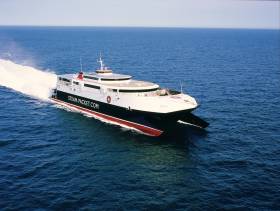Displaying items by tag: Fast Ferry
Irish Ferries High-Speed Craft Returns to Service During Dublin-Holyhead Route's High-Season
Irish Ferries high-speed craft Dublin Swift finally returned to service on the Dublin-Holyhead route with holidaymakers travelling during this summer's key peak-season month, writes Jehan Ashmore.
With the easing of Covid-19 travel restrictions introduced last month, Irish Ferries this week resumed the HSC Dublin Swift service, offering customers an alternative faster option on the Irish Sea's only direct cross-channel fast-ferry service between Ireland and the UK.
Asides the conventional cruiseferry Ulysses and ropax Epsilon, each taking 3 hours 15 minutes to complete, the Dublin Swift's passage time is just 1 hours 49 minutes. This is achieved by the HSC's 35 knot capability when running between the Irish capital and the north Wales port in Anglesey.
Dublin Swift's sailing schedule sees two sailings in each direction daily and with travel restrictions in many countries currently being relaxed, Irish Ferries have introduced additional measures across their fleet to ensure that both passengers and crew can ‘Travel Safe’.
In pre-pandemic times, such fast-ferry operations on the Ireland-Wales link would of begun much earlier, with the season starting in April.
Facilities on Dublin Swift include a Club Class lounge, Brassarie, Cafe, TV lounge, Gaming Zone and Wi-fi connection is available. In addition an on board shop. Noting, that the Irish Ferries website cites that due to the impact of Covid-19, not all advertised ship facilities may be open.
The HSC Dublin Swift, likewise of its predecessor, Jonathan Swift was built by Austal-Ships, Freemantle, Australia in 2001 and can carry 900 passengers, 200 cars and 16 trucks. The twinned hull craft originally entered service for Irish Ferries in 2018 having been acquired as secondhand tonnage.
This year is the first summer season that Irish Ferries can also offer customers an inclusive UK 'land-bridge' service with the opening in June of their new service on the Dover-Calais route. The new UK-France service followed the transfer of cruiseferry Isle of Inishmore from the Rosslare-Pembroke route currently served by the chartered-in Greek flagged ferry Blue Star 1.
In addition, Irish Ferries run direct Ireland-France services on the Dublin-Cherbourg route served by cruiseferry W.B. Yeats. The largest ship of the fleet is supplemented with additional capacity at weekends by Epsilon. This Italian registered ropax was chartered to launch the Ireland-France route in 2014..
The ro-pax ship assists to cater for Brexit related freight market demand on the direct service to continental Europe.
Fastferry Manannan to Remain in Isle of Man for Winter Layover
The Isle of Man Steam Packet's fastferry, Manannan is to remain in Manx waters this winter.
According to EnergyFM, the passenger /vehicle craft concluded the 2019 season earlier this month, maintaining a 100% technical reliability record during the whole summer, according to the company.
Completing 759 sailings and travelling 51,777 nautical miles, the high-speed ferry also operated a 98.15% punctuality record, as the season drew to a close.
Manannan will now be moored in Douglas Harbour before undergoing an annual overhaul ahead of services resuming on 27th March next year.
Click here for more details.
A high-profile royal visit is set to bring out the orange in Cape Clear Ferries’ orange-and-white branding next weekend.
The company’s new fast ferry from Schull and Baltimore to Cape Clear Island will take a different route next Friday 14 June as it transports the Dutch royal family on a special trip from Cork city via Cobh to Crosshaven in Cork Harbour.
Séamus Ó Drisceoil, manager of Cape Clear Ferries, expressed his delight that Dún na Séad II would be considered suitable for such an event.
“Our company has invested and reinvested consistently over the years to raise our standards and we feel that this is an impressive and merited endorsement both of our newest ferry and also our dedicated and hardworking team,” he said.
“Karen Cottrell along with crew members Shane Ó Drisceoil, Cathal Cottrell, Niamh Ní Dhrisceoil and Iain O’Driscoll will be present on the day to welcome on board the Royal Highnesses, King Willem-Alexander and Queen Máxima, as well as Uachtarán na hÉireann, Michael D Higgins and other dignitaries.”

There will be a heavy security presence around the royal ‘boatercade’ with no other unapproved vessels permitted on the river during the visit.
Karen Cottrell said: “We are working very hard to make good of this significant upgrading of the ferry fleet in West Cork by promoting award-winning tours around the iconic Fastnet Rock Lighthouse.
“This is an outstanding natural and historical landmark off the West Cork coast and of course all our tours are via Cape Clear Island also known as ‘The Gateway to the Fastnet’.
“We will be delighted to welcome the royal couple and other dignitaries on board, but in reality all our passengers are special to us.
“In a few weeks’ time we will also welcome on board the chief of the O’Driscoll Clan for their annual visit to Cape Clear Island,” Cottrell added.
Manx Steam Packet Fast Ferry Winters In Douglas Harbour But Birkenhead Service Set to Resume
#FerryNews - Isle of Man Steam Packet's final fast-ferry craft seasonal sailing scheduled for this year ended last Sunday, the operator having confirmed the Manannan will again remain in Manx waters this winter.
The Manannan is currently docked in Douglas Harbour where the InCat built catamaran will spend a winter layover into next year. In advance of returning to service, the craft is to undergo routine annual overhaul before resuming on 29th March 2019 on the craft's main route of Douglas-Liverpool. Afloat adds in the high season, the craft also serves Belfast and Dublin.
As Afloat reported today, the Irish Sea's only 'cross-channel' fast-ferry craft, Dublin Swift operated by Irish Ferries is too wintering albeit in Belfast, however the Austal built craft is scheduled to resume seasonal service on the Dublin-Holyhead route next April.
Returning to the IOMSPCo's conventional ropax ferry, Ben-my-Chree, which continues to operate throughout the season, including daily Douglas-Heysham sailings. In addition to starting this weekend services to Birkenhead on Merseyside. Afloat adds the Twelve Quays Terminal facing opposite of Liverpool, is also where Stena Line operate year round to Belfast Harbour.
According to the Manx operator, during Manannan's season this year the craft has the following statistics:
Operated 773 sailings, travelling just under 55,000 nautical miles
Maintained a 100 per cent technical reliability record
Operated at 98.9 per cent reliability – with only four return trips cancelled due to weather
Had main engines accumulate approximately 9,300 running hours
Steam Packet Company Chief Executive Mark Woodward explained: ‘Once again, Manannan has had a great reliability record this season and plays an invaluable role in the Company’s day to day operation.
‘We constantly look for ways to improve services and respond to unforeseen circumstances so the decision to keep her here until after the busy Christmas period will provide an extra degree of support for our vital sea links at an important time of the year.’
#FerryNews - A new fast ferry has just been commissioned for Cape Clear Island Ferries after completing various surveys and sea trials and a number of modifications to comply with Irish MSO standards.
Dún na Séad II was purchased in Norway earlier this year and arrived in Baltimore in April. It is capable of speeds of up to 20 knots with an operating speed of 18 knots and has a crane and cargo capacity of 6 tons.
Features include airline-style seating with large windows in a comfortable saloon with air conditioning and other features.
Licensed for 97 passengers with upper deck seating that affords outstanding 360-degree views of Roaringwater Bay, the ferry marks a substantial investment for the Cape Clear Island Ferries which owns three other passenger vessels: Dún an Óir II, Dún Aengus and Cailín Óir.
Dún na Séad II will operate primarily on the Schull—Cape Clear route but it is planned to use her occasionally on the Baltimore—Cape Clear route which is the main year-round service to the island.
Current traveling times of 45 minutes from both Schull and Baltimore will be halved when this vessel is in use.
Cape Clear Island Ferries says that the larger vessel together with the shorter journey time more than doubles the potential passenger capacity, and its focus will be on larger groups, bus and coach tours as well as building relationships with complementary service providers.
The ferry company has in recent years focused on soft adventure tourism surrounding the Fastnet Rock Lighthouse, which has shown double-digit growth over the past four years.
Considered the ‘Gateway to the Fastnet’, Cape Clear Island regularly welcomes passengers arriving from both Schull and Baltimore to see the famous rock.
While the company does not offer specific whale-watching trips, whale and dolphin sightings are a frequent occurrence in the area.
Cape Clear Ferries is owned by local shareholders on Cape Clear Island and Baltimore and its management, shareholders and staff are all from the immediate area. The business was established in 2007.


































































